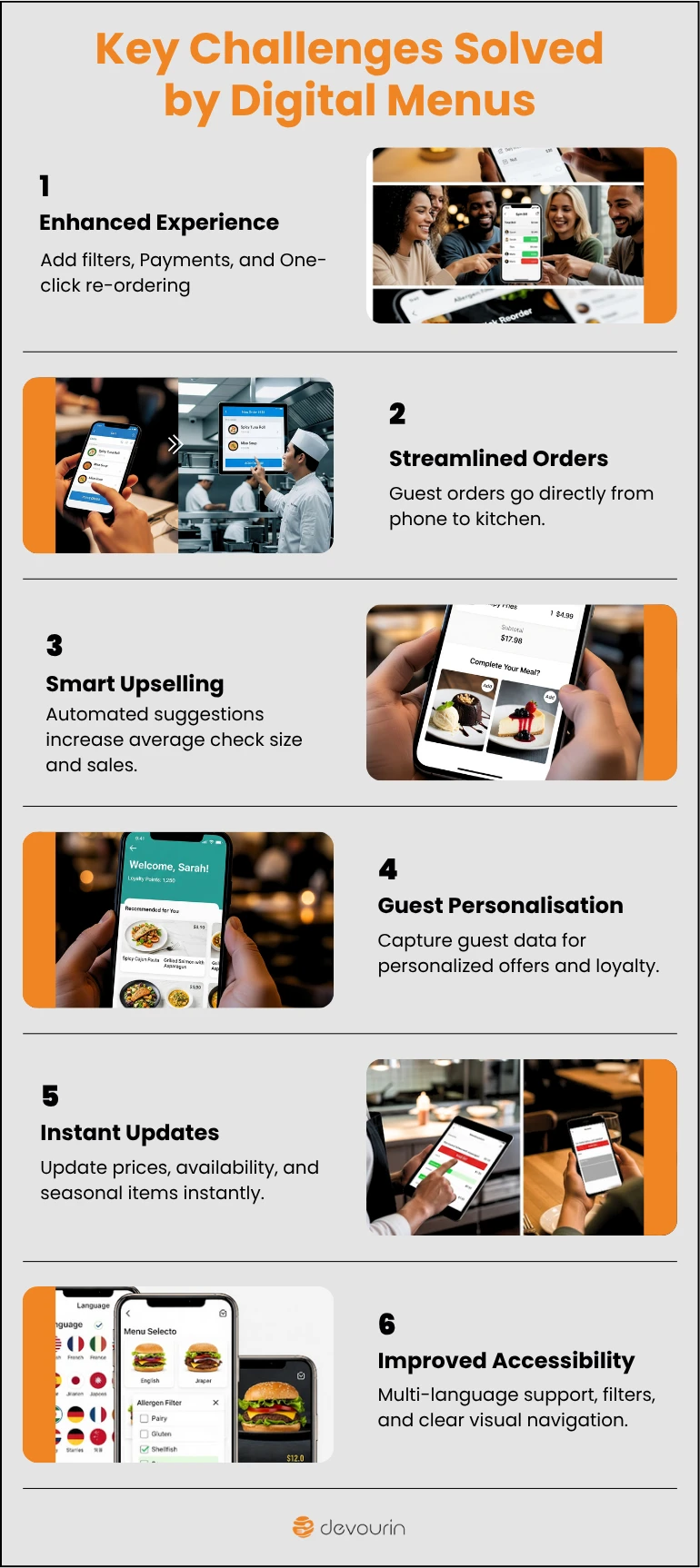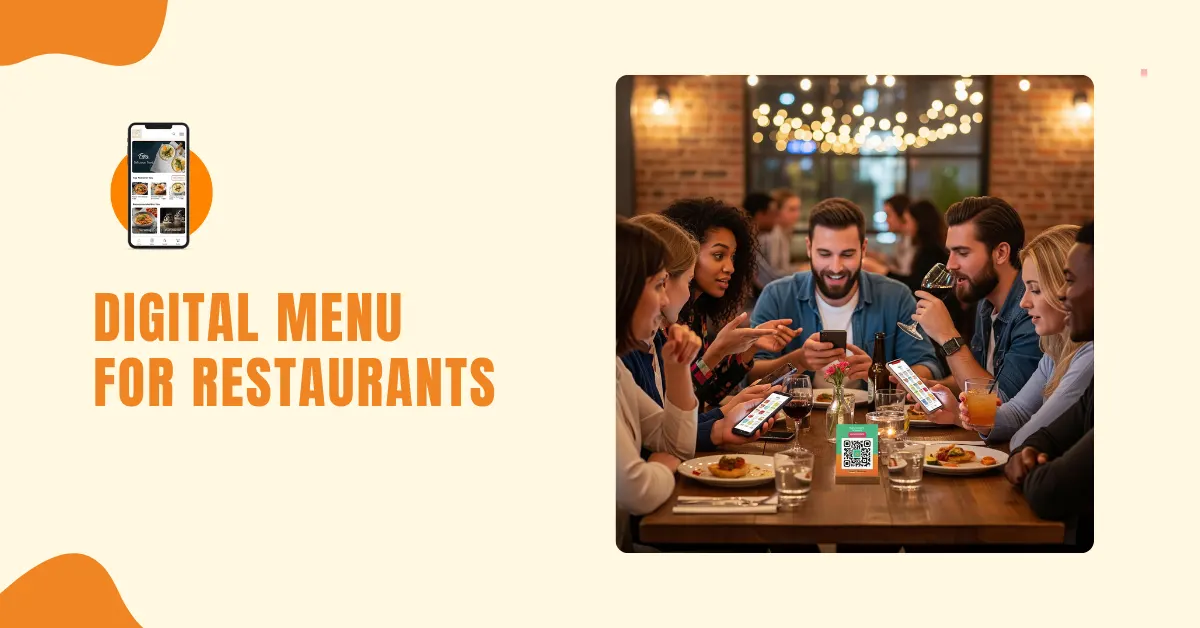From paper to pixel: Why going digital is no longer optional in the restaurant world
The restaurant industry is evolving faster than ever. Diners no longer just want great food, they expect speed, ease, and personalisation with every interaction. A simple printed menu that once helped set the mood now falls short of these rising expectations. In a world where everything from cabs to groceries is a tap away, diners want their food experience to match the pace and flexibility of modern life.
Updating printed menus is time-consuming and expensive. They can’t reflect real-time changes like stock shortages, seasonal updates, or dietary filters. For today’s health-conscious and digitally savvy customers, this becomes a friction point. On the other hand, digital menus bring unmatched convenience. They offer real-time updates, visual appeal, smart filters, integrated ordering, and payment options, all on a device your customer already has in hand.
But digital menus aren’t just about being trendy or cutting paper. They’re reshaping how restaurants operate, upsell, connect with guests, and respond to market changes. Whether you’re running a café, fine-dining restaurant, or cloud kitchen, this technology is no longer optional, it’s strategic.
This guide will walk you through the most common questions about digital menus and how they can unlock new levels of efficiency and guest satisfaction for your business in 2025 and beyond.
Why is the traditional restaurant menu no longer enough?
Printed menus are static. Updating them requires reprinting, which means higher costs and delays. Plus, with diners becoming more health-conscious and tech-savvy, static menus fail to deliver the flexibility and personalisation guests expect. In contrast, a digital menu adapts instantly, whether it’s a seasonal update, a sold-out dish, or a promotional offer.
How is the digital menu reshaping restaurant operations in 2025?
Digital menus have gone from novelty to necessity. They are interactive, mobile-friendly, and built for the modern diner. Beyond displaying dishes, they integrate ordering, payment, personalisation, and loyalty in one platform. They give you agility, reduce waste, and deliver the level of convenience that today’s guests demand.
What will this guide cover?
This resource will explore:
- Key operational challenges and how digital menus solve them.
- Strategic benefits beyond convenience.
- Menu design techniques that boost engagement and sales.
- Practical tips for implementation.
Key Operational Challenges Solved by Digital Menus
While digital menus may seem like a sleek replacement for paper, their true value lies in how they solve day-to-day operational hurdles. From improving order accuracy and speeding up service to enhancing personalisation and boosting revenue, digital menus are central to running a smarter restaurant. Let’s dive into how they tackle specific challenges.

How can a digital menu do more than just take an order?
Challenge: A static menu is functional but lacks engagement.
Solution: Digital menus enhance the dining experience with features like:
- Allergen & Dietary Filters: Guests can instantly find vegetarian, gluten-free, or nut-free options.
- Integrated Payments & Bill Splitting: No waiting for the bill, customers can pay directly on their device.
- One-Click Re-ordering: Frequent diners can quickly reorder their favourites.
How do digital menus help reduce wait times and improve order accuracy?
Challenge: Manual order-taking often leads to errors and delays, especially during rush hours.
Solution: With QR-based ordering:
- Guests place orders directly from their phones.
- Orders sync with the kitchen in real time.
- Built-in allergen and ingredient details reduce mistakes.
Tip: Ensure your menu layout is clear and integrate the system with your kitchen display for smooth workflows.
How can digital menus boost upselling and revenues?
Challenge: Servers may miss upselling opportunities.
Solution: Digital menus enable:
- Smart Recommendations: Suggest add-ons or combos.
- Dynamic Offers: Highlight limited-time deals or trending items.
- Personalised Suggestions: Show preferred dishes based on order history.
Tip: Keep recommendations subtle. Avoid overwhelming customers with too many pop-ups.
What role do digital menus play in tracking guest preferences and enabling personalisation?
Challenge: It’s hard to remember each guest’s preferences manually.
Solution: Digital menus:
- Capture valuable data for loyalty programs.
- Enable customised suggestions.
- Create feedback loops for continuous improvement.
Tip: Always safeguard customer privacy and follow compliance guidelines while collecting data.
Can digital menus help manage menu changes, inventory, and seasonal updates instantly?
Challenge: Printed menus can’t keep up with frequent changes.
Solution: With a digital menu:
- Update prices, dishes, and availability in real-time.
- Sync menu updates with inventory to reduce waste.
- Plan seasonal menus without reprinting costs.
Tip: Create a menu update calendar and link it with your inventory cycle, this ensures seasonal dishes are planned, ingredients are stocked smartly, and updates roll out seamlessly without last-minute chaos.
How does a digital menu enhance guest experience and accessibility?
Challenge: Long menus and language barriers frustrate customers.
Solution:
- Multi-language support for diverse audiences.
- Allergen filters for dietary needs.
- High-quality visuals and clear navigation for easy browsing.
Tip: Use simple fonts, accessible colours, and large buttons for a user-friendly design.
Beyond the Basics: Strategic Advantages of Digital Menus
Restaurants that leverage digital systems effectively gain long-term advantages like better data insights, faster adaptability, and alignment with sustainability trends. Plus, they can integrate effortlessly with your POS, inventory systems, and third-party platforms to create a seamless digital ecosystem.
What are the long-term competitive advantages of adopting digital menus?
- Cost Savings: Digital menus eliminate the recurring expense of printing and reprinting physical menus every time there’s a price change or seasonal update.
- Eco-Friendly Branding: By going paperless, your restaurant reduces its environmental impact and aligns with the values of sustainability-conscious diners.
- Data-Driven Decisions: With built-in analytics, digital menus provide insights into customer preferences and menu performance, helping you fine-tune pricing, offers, and dish placement for maximum impact.
- Adaptability: Whether you’re responding to seasonal availability, changing customer preferences, or sudden trends, digital menus allow you to make instant updates and stay relevant.
How does the digital menu ecosystem connect with other restaurant tech?
- POS Integration: Digital menus can be seamlessly integrated with your restaurant’s Point of Sale (POS) system, allowing orders placed by customers to sync directly with your billing and kitchen operations. This reduces manual entry, minimises errors, and speeds up the entire order-to-payment process.
- Inventory Management: When connected with inventory management tools, digital menus can track stock levels in real time. If an item is running low or sold out, it can automatically be removed or marked unavailable on the menu, helping you avoid customer disappointment and reduce wastage.
- Third-Party Platforms: Digital menus can also integrate with third-party platforms like Swiggy, Zomato, or food aggregators. This ensures consistency across channels, so updates to prices, availability, or dishes reflect instantly, whether customers are dining in or ordering online.
The Foundation: Applying Menu Psychology to the Digital Screen
A well-designed digital menu doesn’t just display food, it influences behaviour. The limited real estate of a phone screen requires strategic thinking. Smart menu psychology, from where you place high-margin dishes to how you describe them, can significantly impact how customers order. Digital tools allow you to implement these principles with precision.
Challenge: On a small mobile screen, everything can look the same.
Solutions:
- Visual Hierarchy: On a mobile screen, every dish can start to look the same if there’s no visual strategy. That’s where visual hierarchy comes in. Use elements like larger images, contrasting colours, or subtle animations to make certain dishes stand out. Add small, persuasive labels like “Chef’s Special”, “Bestseller”, or “Customer Favourite” to highlight popular or high-margin items. Including high-quality, appetising images alongside these labels increases the likelihood of selection, people often eat with their eyes first.
- Digital Golden Triangle: Just like on printed menus, a user’s eyes are drawn to certain areas of a mobile screen, primarily the top, centre, and slightly to the right. This is known as the Digital Golden Triangle. Placing your high-margin, signature, or promotional dishes in these zones improves their visibility and boosts conversions. Ensure these dishes are designed to stand out both visually and contextually, so they catch the user’s attention during their quick scroll.
- Smart Descriptions: Words matter. A bland label like “Grilled Sandwich” doesn’t inspire much excitement. But a smart, sensory description like “Crispy grilled sandwich with gooey cheddar, served with our house-made dip” sparks appetite and imagination. Well-written menu copy can highlight textures, flavours, or pairings (e.g. “Perfect with a chilled craft beer”), guiding the customer toward combinations that boost satisfaction and order value.
- Decoy Pricing: Decoy pricing is a clever psychological trick that works even better on digital menus. By placing one or two premium-priced items at the top of a category, you shift the perception of value. For instance, a ₹1,200 steak makes the ₹800 pasta feel like a better deal in comparison, even if the pasta is your actual hero dish. This technique subtly nudges customers toward higher spend without making them feel pressured.
Conclusion: The Menu as a Growth Engine
A digital menu is a central pillar of a future-ready restaurant. It brings together speed, efficiency, personalisation, and data-driven insights in one seamless experience. Whether you’re managing multiple outlets or running a single-location café, a digital menu can streamline your operations, reduce costs, and create meaningful guest interactions. Most importantly, it helps you stay agile in a fast-changing industry. From real-time updates to integrated loyalty and upselling features, it empowers you to do more with less. Investing in a digital menu isn’t just smart, it’s essential for long-term success.
Ready to upgrade your restaurant experience?
Explore how Devourin’s digital menu solutions can help you grow smarter.
Author
-

With over 18 years of writing and editorial experience spanning lifestyle, hospitality, luxury, and corporate sectors, Radhika brings a seasoned perspective to content that informs, engages, and inspires.
At Devourin, Radhika combines deep industry insight with editorial precision to produce content that not only reflects the evolving needs of the food and restaurant industry but also drives connection, clarity, and growth.
Throughout her career, Radhika has written for leading brands and platforms. She is also the founder of KathaCraft, a boutique content studio focused on purposeful storytelling across diverse mediums.
Profile: LinkedIn


